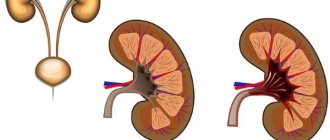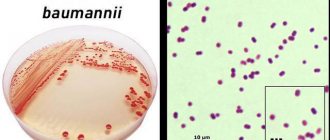Light yellow urine is an indicator of human health. The shade of this biological fluid can change significantly during the day; in the morning the urine is more saturated in color, and in the afternoon it is lighter.
Urine acquires its yellow color due to pigments, the main of which is urobilin, which is formed from its precursor bilirubin in the liver. Next, bilirubin enters the intestines with bile, and under the influence of microflora it breaks down to urobilin. In parallel with it, urobilinogen is formed. However, it colors urine after it is released into the external environment.
The color of urine also depends on external factors: food, taking medications and vitamins, and the amount of fluid you drink. Changes against the background of these factors should be taken calmly. However, if lemon-colored urine is released for a long time, then it is worth considering what kind of pathology this color may be a sign of. The article will explain why urine is bright yellow in women and what causes this phenomenon.
Dependence of urine color on drinking and eating
The appearance of urine with other color shades is provoked by various reasons, including drinks and food consumed previously. Urine changes straw color to:
- pink because of beets and dishes that contain them;
- orange due to eating carrots;
- green after eating asparagus. This is confirmed by an unpleasant, pungent odor from the mouth;
- clear or greenish after drinking too much beer. The resulting shade is determined by the type of alcoholic drink;
- brown due to rhubarb, aloe and beans.
Also, yellow urine changes under the influence of pumpkin, blueberries, blackberries and blueberries. The listed vegetables, berries and herbs have a common property. They contain a large number of coloring pigments, which enter the digestive and then excretory systems. Coloring can occur due to the presence of artificial additives (dyes, flavors, preservatives) in food.
After some time, the substance that colored the urine is completely eliminated from the body, therefore, the alarming sign disappears. Therefore, if there is an abnormal shade of urine, do not panic. Perhaps these are the consequences of a previous meal.
Why does urine turn yellow?
The normal color of urine is straw yellow, light, but if it becomes saturated, then this is a sign of disorders. Pathological impurities in the form of blood, mucus and pus are of clinical significance; the bright yellow tint is a borderline state between physiological and pathological. Often the human body copes with minor disturbances on its own, but the pathology may worsen.
Yellow urine in women has many causes. They can be caused by external and internal factors. Urine is a natural way of excreting filtered blood, so all harmful, nutritious and other substances are released into the environment with urine. It turns out that the color of urine directly depends on the composition of the blood and other physiological fluids. As its density increases, due to low fluid intake or excessive moisture retention in the tissues (edema), it also acquires a more saturated color.
Urine color when dehydrated
Factors causing color change
Not only food and drink affect yellow urine. There are several other important reasons. Firstly, metabolic metabolism. This is the most obvious reason, since in most cases, coloring of urine occurs due to waste products from the body. Secondly, age; in an adult, the shade of urine is normally much darker than in a child. A newborn cannot have yellow urine; it is almost always clear. Sometimes, due to an increase in the concentration of uric acid, the urine turns red. Infants often produce light yellow urine.
Thirdly, the volume of fluid consumed. The need for large volumes of water is subsequently expressed as light yellow or clear urine. If a person does not exceed the daily fluid intake, then this symptom indicates advanced kidney disease.
Fourth, taking medications. Fifthly, pathological changes in the body. The last factor is more dangerous than all the others. A lemon-colored urine indicates the presence of infectious diseases that are in the acute phase. Kidney damage, dehydration, or complications from severe burns are also suspected.
Colorless, pale yellow urine is a symptom of both forms of diabetes (sugar and non-sugar diabetes) and chronic renal failure in the first stage. Both diseases are characterized by polyuria, in other words, a large amount of urine excreted.
Dark brown liquid is an indicator of hemolytic type anemia. This diagnosis is confirmed by an increased concentration of urobilinogen in urine. Black color is characteristic of malnosarcoma, hemolytic kidney in the acute stage, alkaptonuria.
Recommended topic:
Causes of cloudy urine in women
Bright red urine appears when internal bleeding occurs. This is possible with oncological pathologies of the urinary system, hemorrhagic cystitis, the presence of stones in the bladder and kidney infarction.
Shades of urine
The hue of urine, reminiscent of meat slop, indicates glomerulonephritis. Beer-colored urine (a mixture of green and brown) is provoked by the presence of urobilinogen and bilirubin in it, as well as parenchymal jaundice. The milky tint of urine warns of the penetration of lymph into it, which is caused by diseases that cause lymphostasis in the kidney.
Greenish-yellow urine is formed with obstructive jaundice. The whitish tint of the fluid excreted from the body can be explained by fatty degeneration of the kidney. A sign of this phenomenon is the release of phosphate crystals, pus (dead leukocytes) and fat itself. The normal color of urine in combination with cloudy sediment (sand) raises suspicions of kidney stones.
Brown urine (the shade of strong brewed black tea) indicates a disease that causes dysfunction of the gallbladder, its ducts and liver. Flakes in urine are a symptom of inflammation of the bladder, kidneys and urethra. Foam in the urine appears due to sperm, therefore, this phenomenon can only occur in men.
What to do
The main question that worries everyone who is faced with a change in urine color is what to do about it. From all of the above, we can conclude that there are reasons that require direct contact with the attending physician and normal physiological characteristics that appear in women and men.
If you notice a change in the color of your urine, analyze your lifestyle over the past few days. Remember what you ate and drank, what your general health was like. In most cases, no medical intervention is required, just pay attention to adjusting the drinking regime.
Check your usual menu for the presence of coloring products, stop taking pills that can affect urine in this way, of course, unless we are talking about medications that are vital for you.
This unexpected manifestation may occur among sports fans. In this case, it is recommended to slightly reduce the level of physical activity. Women during pregnancy should also approach such a change without panic. In most cases, the color change is explained by simple reasons. However, if you have been experiencing bright yellow urine for a long time, and adjustments made to your usual lifestyle do not have any effect on this, it is important to go to the doctor.
Medicines
Yellow urine often changes with drug therapy. Many medications provoke the appearance of abnormal shades. This does not mean that they should be stopped. The symptom will disappear after completing the course of the drug, the components of which color the urine.
Saturated yellow color of urine occurs in women or girls when eliminating signs of cystitis with the help of Nitroxoline. Brown urine often appears after cleansing the body with activated carbon; treatment of infectious diseases affecting the genitourinary system; taking antibiotics or drugs that have a laxative effect. Methylene blue, used against canker sores and herpes, turns urine green or blue. Bright yellow urine appears when consuming folic acid, mineral complexes, and Riboflavin multivitamins (vitamin B2).
Antibiotic drugs give urine shades other than brown. For example, “Fosfomycin” causes an orange color, “Rifampicin” causes a red color. The latter is included in the therapeutic regimen of people with tuberculosis. Also, urine will become a different color due to the following medications:
- "Furagin";
- "Canephron";
- "Phytolysin";
- "Quinine" and its derivatives;
- "Warfarin";
- "Nitrofurantoin";
- "Sulfamethoxazole";
- "Furacilin".
Anemia tablets containing ferrous sulfate darken urine. The same thing happens when taking laxatives. “Aspirin” provokes the release of urine with a pink tint; a drug called “Amidopyrine” can give it a red color.
Causes and pathological signs
If darkening or brighter color of urine is not a consequence of a change in diet or lifestyle, then the cause should be sought in pathological changes in the body. Most often, a sign of urine such as its color can be changed by:
- problems with kidney function;
- disorders of the genitourinary system;
- malfunction of the digestive organs.
Experts do not rule out the activity of physical processes when searching for the cause of the bright yellow color of the material for research. During intense physical activity, the metabolism in the human body increases, which provokes a change in color.
A component called bilirubin, which is processed in the gallbladder, liver and gastrointestinal tract, is responsible for the color of urine. It is partially processed in the kidneys. If we are talking about children, then such a sign as the color of urine can change against the background of hemolytic disease, physiological jaundice, which manifests itself in the first weeks of life.
We cannot exclude disturbances in the water balance in the body, diseases for which severe swelling is a clear sign. Intestinal infections and excessive sweating can affect children's urine in this way. When working with adults, cirrhosis of the liver and chronic diseases of the cardiovascular system cannot be ruled out.
It is important to note that the use of certain medications, in particular laxatives or antibiotics, leads to the darkening of urine and its acquisition of brighter shades. Bright yellow urine is usually present in babies in the first weeks of life.
If we talk about children, then the combination of dark urine with nausea, hyperemia, excessive sweating, vomiting, swelling, pain in the lumbar area or under the right hypochondrium should alert the parent. If any of these symptoms are present and the urine color is not normal, your doctor will order additional diagnostics and tests to clarify the diagnosis.
Other causes of urine color change
These include:
Recommended topic:
Cloudy urine
- Pregnancy
Changing the color of urine when expecting a baby is rare. Such an anomaly will not occur if a woman eats properly and leads a healthy lifestyle. Otherwise, hematuria (change from yellow urine to red) will not take long to occur. Its consequences are dangerous both for embryos (miscarriage is possible) and for infants who have suffered the negative effects of hematuria during intrauterine development.
Causes of urine color change - pregnancy
In any case, a pregnant woman's urine will be darker than usual. While pregnant, a woman should not drink water or other drinks excessively, as this causes swelling. If a dangerous symptom appears, you should definitely contact a specialist. He will prescribe a general urine test; if acetone is detected, the doctor will prescribe additional procedures to confirm or refute suspicions of acetonuria.
- Excessive physical activity
Athletes often have darker urine. The reason for this is regular physical activity, which causes increased sweat production. Because of this, the amount of fluid in the body decreases and the concentration of coloring pigment increases. Light yellow urine returns after water balance is restored.
- Alcohol abuse
Long-term binges and short-term drinking sessions can cause urine to darken to an acidic or amber hue. Alcohol syndrome is fraught with consequences, including poisoning of the body with waste and toxins. Removal of ethanol breakdown products occurs through the liver and urinary system.
- Blood transfusion
In this case, the urine turns red due to the ingress of a large number of red blood cells.
Additional symptoms will help determine the exact cause of changes in urine color. If your lower back or stomach hurts, your skin becomes yellow, vomiting occurs frequently, or you have a depressive disorder, you should inform your doctor about this. It is possible that these signs and the abnormal color of urine refer to symptoms of the same disease.
Pregnancy
As you know, pregnant women undergo serious changes in the body; it must work for two; many processes have not been fully studied.
Dark urine in pregnant women
For a pregnant woman, all systems function in an enhanced mode, which is why changes during this period may be far from expected. Urine during pregnancy can change color from lemon yellow to brown.
But it is worth knowing that in the early stages the color of urine should not be fundamentally different from what it was. A change in the color of urinary fluid is not a reason to panic. This phenomenon is often explained by vitamin complexes that are prescribed during pregnancy.
The most popular of them will be Elevit, Vitrum Prenatal Forte. They contain groups of vitamins A and C. They are the ones that can give urine a too bright shade.
Also, do not forget about antibacterial drugs, because they also have this property. Another reason may be the pregnant woman’s consumption of certain foods (carrots, pumpkin, citrus fruits). Very often this is a reaction to food consumed, vitamin complexes, which are often prescribed to pregnant women. If after a few days the color of the urinary fluid does not return to normal, then you should consult a doctor. After all, you can miss a serious pathology.
Pregnant women need to be especially attentive to their well-being so as not to miss the early signs of gestosis (nausea, vomiting, emotional lability)
Very often, the presence of bright yellow urine indicates toxicosis, because with this pathology, dehydration occurs due to vomiting. And if it is difficult to fight toxicosis, then replenishing lost fluid is a very real mission.
Meanwhile, too light a shade of urine is not the norm. This phenomenon indicates a weak concentration of this liquid. And this may be a sign of diabetes, namely the gestational type. It is accompanied by constant thirst, dry mouth, and a huge amount of excreted urinary fluid.
Effect of hormones
The endocrine system affects the functioning of all vital organs
The endocrine system affects the functioning of all vital organs. The hormones produced by it contribute to the inhibition or activation of various body functions. Failures in their formation entail negative consequences, in particular, they provoke diseases, which, in turn, cause a change in the color of urine.
One of the characteristic symptoms of diabetes is clear urine. The pathology itself is caused by problems with insulin. Antidiuretic hormone increases the density of urine, causing it to darken.
It is not recommended to get rid of an alarming symptom through traditional methods of treatment. To return normal yellow urine, you should act on the root cause, which is impossible to determine without the participation of a specialist. Therefore, do not take risks, but contact a medical facility.
Preventive measures
The simplest preventive measure is to limit the intake of brightly colored vitamins, vegetables and fruits. Controlling the drinking regime is important for correcting the body’s water balance. Dehydration is especially dangerous in a pregnant woman, as it can negatively affect the health of the unborn child.
It must be remembered that even a breastfed baby needs additional fluid in hot weather.
Since inflammatory and infectious processes can also cause urine to turn beer-colored in men and women, you also need to monitor your sexual health. A timely consultation with a specialized doctor will help eliminate the symptom as quickly as possible.
Urine color has changed
The color of urine changes according to physiological indicators (color is restored over time after the cessation of the changing factor) and pathological (due to disease).
Sometimes the excretory fluid changes after prolonged exposure to the disease. Often, if a disease of the urinary system appears, the color changes and the person can detect it himself. If these symptoms occur, you should consult a doctor immediately.
Common causes of urine discoloration
Physiological reasons that color urinary fluid include:
- Consumption of foods that change color. If a person eats a lot of carrots, oranges, tomatoes, the urine will become bright orange. A black, burgundy tint appears when eating fruits and vegetables with strong pigment (beets, blackberries, raspberries). Drinking strong tea in large quantities turns the excretory fluid brown.
- Consumption of substances containing high concentrations of coloring enzymes.
- Increased body or environmental temperature for a long time. Water leaves the body through sweat and the lungs. Blood plasma becomes less, and so does urine. Therefore, it acquires a bright shade, becomes cloudy, and less of it is formed. Possible dehydration.
- Drinking large quantities of water changes the color of urine to light yellow, it becomes almost colorless. Decreasing drinking makes it dark.
- Pregnancy. There may be a slight fluctuation in shade as a woman’s hormonal background changes. If a woman develops edema, doctors advise drinking less water, so the excretory fluid darkens and becomes highly concentrated.
The following colors are distinguished that appear in diseases:
- A pale shade (with sufficient water intake) appears when the excretory function of the kidneys decreases, when they pass a reduced amount of substances through the filtration barrier. Urine volume is maintained or increased.
- A dark brown color is given to urine due to increased secretion of the pigment bilirubin, which is not detected in healthy people. This condition occurs when the liver becomes inflamed or due to hemolysis (increased destruction) of red blood cells. Both diseases are manifested by jaundice of the skin and sclera. With hepatitis, an additional sign is the formation of foam in urine analysis.
- A brown tint (the color of beer) appears with cirrhosis or advanced hepatitis of the liver.
- A red color appears when blood or red blood cells enter the urinary canal. In the first case it will have a bright shade, in the second it will be pink. The cause is injuries to the urinary canal or kidneys, pyelonephritis, cystitis. If hematuria (blood in the urine) was caused by stones passing through the urinary system, sand, mucus, pus, and salt grains will be detected in the analysis.
- Purple appears when poisoned by poisons or the use of certain medications. The reason for this is extensive hemolysis of red blood cells.
- Blue color is a rare phenomenon. It happens with hereditary kidney pathologies that cause hypercalcemia (increased calcium in the blood). Infection with pseudomonads is accompanied by a blue coloration of the biological fluid due to the release of their waste products.
What determines the color of urine
The color of biological fluid in the body depends on the person’s diet. Foods containing natural and artificial colors change its color. The shade depends on the quality of a person’s metabolism, with the help of which substances enter the excretory fluid.
The liquid consumed per day for an adult should be at least 2 liters. With the help of water, urine is diluted, making it less concentrated.
Causes of urine stagnation in the kidneys: diagnosis and treatment
Hydronephrosis is stagnation of urine in the kidneys, enlargement of the renal system and its calyces. According to statistics, the disease affects women more often than men. The development of hydronephrosis in men most often ends with prostate cancer, urethral stricture, and in young people the disease is caused by urolithiasis. Congestion in the kidneys is characterized by the accumulation of fluid in the renal cups, as a result of which the functionality of the renal system is disrupted and a pyelocaliceal pathology is formed. Hydronephrosis can be infected or aseptic. In this article we will tell you why urine stagnation occurs in the kidneys, we will analyze the symptoms, diagnosis and treatment of the pathology.
Reasons for the formation of stagnant urine
Hydronephrosis is stagnation of urine in the kidneys, enlargement of the renal system and its calyxes
Impaired functioning of the renal system and the formation of stagnation of urine can occur due to the following reasons:
- the presence of pathological processes in the urethra and bladder; such a disorder can be provoked by tumor processes, previous infectious diseases, phimosis;
- external compression of the ureter, which is formed due to a violation of the lymphatic system, cysts, after surgery;
- changes in the lumen of the ureter caused by urolithiasis, torsion or kinking of the ureter caused by injury or congenital disorder;
- congenital anomaly or the presence of VUR, which can impair the functioning of the renal system and pelvis.
For information! There are congenital hydronephrosis, which forms in fetal development, and acquired hydronephrosis, which occurs as a result of damage to a previously healthy kidney.
Stagnation of urine in the kidneys during pregnancy is considered a fairly common phenomenon. The disorder occurs due to changes in hormonal levels, which affect the rhythmic contractions of the ureter. The last trimester is dangerous because due to the increase in the size of the uterus, mechanical compression of the ureter occurs. To monitor the situation and the health of a pregnant woman, a urine test is taken on a regular basis for culture, and if obvious deviations from the norm are confirmed, therapy is carried out.
Symptoms of hydronephrosis
With chronic stagnation of urine in the kidneys, the patient feels attacks of severe pain in the lumbar region
At the initial stage of hydronephrosis, a person does not feel any symptoms or changes in his health. There may be a feeling of general malaise, tiredness or increased fatigue. It is precisely because of the absence of symptoms that it is quite difficult to identify the problem, however, it is possible with a random examination. The main symptoms of congestion include:
- the organ increases in size and weight;
- the organ acquires a blue-red color;
- the appearance of yellow spots;
- tense state of the renal capsule;
- pronounced venous pattern;
- connective tissue shrinks as a result of which the organ acquires an uneven surface;
- with enlargement of the glomeruli, red spots are observed;
- during a period of prolonged stagnation, atrophy of the renal substance occurs and its replacement with connective tissue;
- the kidney substance changes to fat.
With chronic stagnation of urine in the kidneys, the patient experiences the following symptoms:
- attacks of severe pain in the lumbar region;
- intense pain attacks radiating to the genitals appear after eating food;
- irregular attacks of nausea and vomiting;
- temperature rise to 39C degrees;
- presence of blood clots in urine.
For information! In urological practice there is such a thing as a congestive kidney. This condition is accompanied by poor circulation, resulting in heart failure.
Most often, the chronic form passes without permanent symptoms; attacks are increasing and intermittent. If you feel discomfort and notice changes, contact a specialist for advice.
Diagnosis of the disease
The purpose of diagnostic measures is determined based on the patient’s complaints
The purpose of diagnostic measures is determined based on the patient’s complaints and includes:
- general urine analysis;
- biochemical and general blood test;
- ultrasound examination of the bladder and renal system;
- examination of the urinary system using magnetic resonance imaging;
- intravenous urography;
- CT scan;
- retrograde pyelogram;
- radionuclide research.
For information! Diagnostics allows you to determine the pathological disorder of the internal structure of the organ, and also reflects the general condition of the vessels and ureter.
Microscopic examination reveals how dilated the vessels are, as well as the presence of protein in the collapsed capillaries and tubules.
Treatment of hydronephrosis
To reduce and prevent pain, the patient is prescribed painkillers and antibacterial medications.
Long-term morphology of the disease significantly impairs the functionality of the renal system and causes renal failure. Stagnation of urine in the kidneys causes the following complications:
- pyelonephritis of all forms;
- stone formation;
- progression of inflammatory processes throughout the body, which can result in death;
- secondary reduction in kidney size;
- a sharp increase in blood pressure.
If the disease is confirmed, treatment should be started immediately. To reduce and prevent pain, the patient is prescribed painkillers and antibacterial medications. Normalization and restoration of urine outflow is carried out using surgical intervention. The choice of surgery depends entirely on the cause of congestion in the kidneys.
Catheterization
This operation is performed in the presence of a malignant or benign tumor in the prostate gland, as well as in the presence of sclerosis of the bladder neck
This operation is performed in the presence of a malignant or benign tumor in the prostate gland, as well as in the presence of sclerosis of the bladder neck. The site of narrowing of the ureter is widened using a ureteral stent and an endoscope is inserted to perform retrograde pyelography.
Percutaneous nephrostomy
Using ultrasound, an external drainage is installed into the cavity system of the organ; the drainage helps urine flow into the external collection system.
Carrying out open surgery
Open surgery is performed if there are indications:
- the presence of a tumor in the retroperitoneal region;
- the presence of stones that cannot be eliminated endoscopically or with shock wave therapy;
- presence of retroperitoneal fibrosis;
- with pathological dilatation of a blood vessel.
Endoscopic method
Used in the presence of stones that prevent normal urine flow. Any surgical intervention can partially or completely remove the cause of the formation of compression of the kidney, however, the result of the operation completely depends on the stage and form of the disease.
Disease prevention
Timely and high-quality implementation of preventive measures to eliminate the causes of hydronephrosis contributes to the complete and rapid restoration of the functioning of the renal system. With a long-term and bilateral course of the pathology, the prognosis of the pathology ends with the appointment of hemodialysis or a kidney transplant. The main preventive measures for the formation of stagnation in the kidneys include:
- daily observance of personal hygiene rules;
- maintaining a healthy lifestyle;
- prevention of pathologies of the genitourinary system;
- timely treatment and prevention of infectious diseases, including sexually transmitted diseases;
- following a diet with a reduced amount of table salt, as well as a complete abstinence from alcoholic beverages.
Remember, the development of the disease and its complications can be prevented only by strictly following all recommendations, timely examination and treatment.











